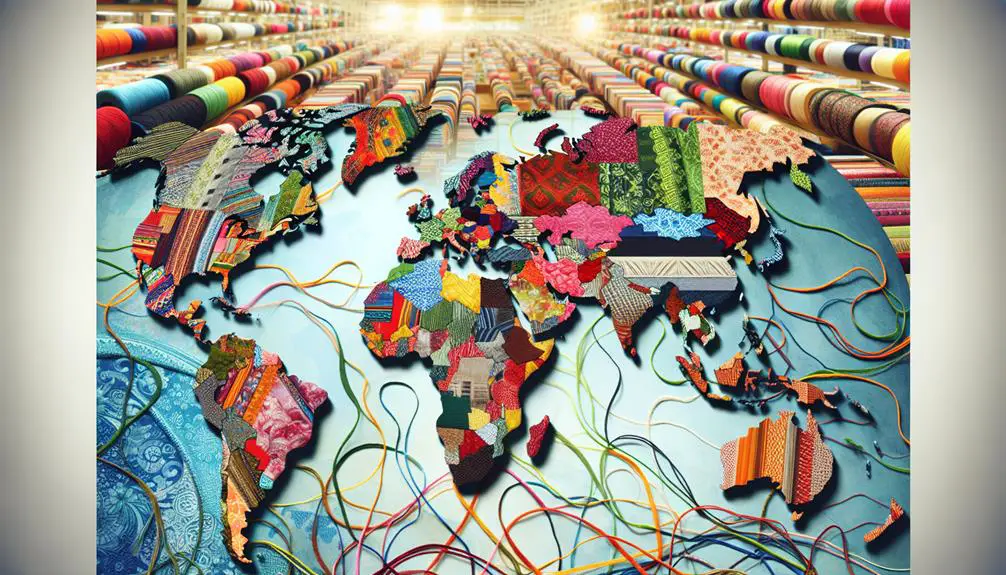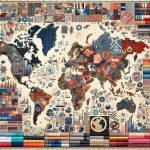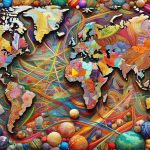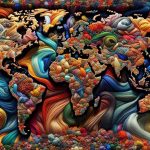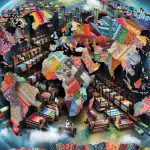You might not realize it, but fabric has a profound impact on the global economy, touching various aspects from job creation to trade dynamics. Major production hubs like China, India, and Bangladesh aren't just producing cloth—they're creating millions of jobs and supporting entire communities. When you consider how traditional craftsmanship merges with modern technology, it's clear that fabric production does more than boost local economies; it also preserves cultural heritages. But how do economic policies and market trends shape the industry's future? Let's explore how these elements interact and their broader implications.
Table of Contents
Key Takeaways
- Fabric production creates millions of jobs, boosting local economies and supporting livelihoods globally.
- Import tariffs and economic policies significantly shape the competitive landscape of fabric exports and trade flows.
- Sustainable fabric production practices help reduce environmental impact while meeting growing market demand.
- Technological advancements in manufacturing enhance efficiency, reduce costs, and drive industry innovation.
- Textile artistry preserves cultural heritage, fostering pride among artisans and supporting traditional craftsmanship.
Global Production Hubs
Key fabric production hubs like China, India, and Bangladesh drive the global textile industry. In these regions, you'll find a seamless integration of traditional craftsmanship and modern technology that optimizes the supply chain. China, for example, excels in large-scale production efficiency, leveraging advanced machinery to meet high demand. India, known for its rich textile heritage, combines artisanal skills with industrial capabilities, ensuring a diverse product range.
Understanding market trends is vital for staying ahead. These hubs often set the pace for what's in vogue, thanks to their rapid response to global demand shifts. By closely monitoring these trends, you can anticipate what fabrics and designs will dominate the market. Bangladesh, on the other hand, has carved a niche by offering competitive pricing without compromising on quality, thus becoming a preferred choice for many international brands.
To truly master the fabric industry, you must grasp how these hubs influence the entire supply chain. From sourcing raw materials to final production, every step is meticulously planned and executed. By studying these production powerhouses, you'll gain valuable insights into optimizing your own operations, ensuring you stay competitive in a constantly evolving market.
Trade and Export Dynamics
Understanding trade and export dynamics is necessary for maneuvering the global fabric market effectively. You need to grasp how import tariffs shape the competitive landscape. High tariffs can make foreign fabrics less appealing, pushing you to source locally or seek alternative markets. Conversely, low tariffs open doors to international suppliers, enhancing your options and enabling more competitive pricing.
Economic policies play an important role too. When a country implements favorable trade agreements or subsidies, it can significantly impact fabric exports. You must stay ahead of these policies to capitalize on new opportunities or mitigate potential risks.
Keeping an eye on market trends is equally crucial. For example, a surge in sustainable fabric demand can shift trade flows, benefiting exporters who adapt quickly.
Supply chains are the backbone of your operations. Efficient supply chains reduce costs and improve delivery times, necessary for staying competitive. Disruptions, whether due to geopolitical tensions or natural disasters, necessitate contingency planning.
Employment and Livelihoods
You'll see how the fabric industry creates job opportunities worldwide, giving a significant boost to local economies.
It's crucial in supporting small businesses that rely on fabric production and trade.
As you explore this, consider the livelihoods sustained by this indispensable sector.
Job Creation Worldwide
The global fabric industry creates millions of jobs, providing livelihoods for countless families worldwide. By fueling economic growth and fostering social development, it plays a pivotal role in stabilizing communities. The sector's influence on the labor market is immense, offering diverse opportunities that range from manufacturing to retail.
You can see the impact in three key areas:
- Economic Growth and Social Development: The fabric industry doesn't just create jobs; it propels economic growth. With increased employment, more families can afford better living standards. This, in turn, promotes social development by improving access to education and healthcare.
- Labor Market Expansion: The industry diversifies the labor market, accommodating workers with varying skill levels. From highly skilled designers to factory workers, there's a place for everyone. This diversity helps stabilize economies by reducing unemployment rates.
- Skills Training: The demand for skilled labor in the fabric industry drives extensive skills training programs. These programs equip workers with the expertise needed to excel, fostering a more capable and efficient workforce.
Focusing on these areas, the fabric industry not only contributes to economic stability but also enhances the quality of life for millions globally.
Boosting Local Economies
Local economies thrive when the fabric industry invests in community-based production and retail. By supporting local artisans, you contribute directly to community development and economic growth. These artisans often possess unique skills passed down through generations, and your investment helps preserve these cultural heritages while fostering a sense of pride and identity within the community.
When you purchase locally-made fabrics, you're not just buying a product; you're fueling market expansion that benefits everyone. Local artisans can scale their operations, hire more employees, and improve their livelihoods. This ripple effect strengthens the economic fabric of the community, creating a stable environment where businesses can flourish.
Furthermore, community-based production reduces the economic divide by providing equitable opportunities for employment. You help create jobs that pay fair wages, empowering individuals to support themselves and their families. This, in turn, boosts local spending power, which fuels further economic activities.
Investing in local fabric industries also promotes sustainable practices. Artisans often use eco-friendly materials and methods, aligning with global sustainability goals. By choosing locally-produced fabrics, you're making a conscious effort to support both economic growth and environmental stewardship.
Supporting Small Businesses
By investing in locally-made fabrics, you bolster small businesses that play a crucial role in creating employment and sustaining livelihoods. Small fabric producers often collaborate closely with artisans, fostering artisan partnerships that result in unique, high-quality products. When you select these fabrics, you provide entrepreneurial support, aiding these businesses to thrive and contribute to community development.
Backing small fabric businesses isn't just a purchase; it's an investment in economic empowerment. These enterprises can offer stable jobs, skill development, and a sense of pride within the community. Here's how your support makes a significant impact:
- Job Creation: By opting for local fabrics, you help create and maintain jobs within the community, reducing unemployment rates and boosting local economies.
- Skill Preservation: Artisan partnerships ensure that traditional skills and techniques are preserved and passed down through generations, maintaining cultural heritage.
- Community Growth: Your investment promotes community development by enabling small businesses to reinvest their profits locally, enhancing infrastructure, education, and overall well-being.
In essence, supporting small fabric businesses is a potent way to drive economic empowerment and foster sustainable development within communities. Your choices matter, and they can catalyze positive change on a global scale.
Technological Advancements
You can't overlook how technological advancements are transforming the fabric industry. Innovations in smart textiles, sustainable fabric production, and automation in manufacturing are reshaping how fabrics are produced and used.
These changes not only boost efficiency but also have significant economic impacts globally.
Smart Textiles Innovations
Innovative smart textiles are revolutionizing the fabric industry by integrating cutting-edge technology into everyday materials. Imagine fabrics that don't just cover you but also interact with your surroundings and provide real-time data. Wearable technology is taking a massive leap forward with these advancements, making your clothing more functional and engaging.
Interactive fabrics can monitor your health, adjust to temperature changes, and even charge your devices.
Smart textiles offer numerous benefits:
- Enhanced Health Monitoring: These fabrics can track essential signs such as heart rate and temperature, providing critical data for both athletes and medical patients.
- Adaptive Clothing: Imagine clothing that adjusts to weather conditions, keeping you warm in the cold and cool in the heat. This adaptability ensures comfort and efficiency.
- Energy Harvesting: Some smart textiles can convert kinetic energy into electrical energy, allowing you to charge your devices on the go.
Sustainable Fabric Production
While smart textiles are changing how we interact with clothing, advancements in sustainable fabric production are equally transforming the environmental impact of the textile industry. You'll find that ethical sourcing and eco-friendly practices are now at the forefront of this transformation. Companies are increasingly prioritizing the use of organic, renewable, and biodegradable materials, minimizing environmental footprints from the very beginning of the production process.
In sustainable fabric production, the circular economy is key. You're looking at systems where waste is minimized and resources are reused, creating a closed-loop system that reduces the need for new raw materials.
For instance, upcycling old garments into new fibers ensures that fewer textiles end up in landfills.
Zero waste initiatives push this concept even further. Innovative manufacturing techniques now allow you to produce fabrics with minimal waste. Advanced technologies, such as 3D knitting and digital printing, enable precise usage of materials, virtually eliminating offcuts and scraps.
Automation in Manufacturing
Automation in manufacturing has revolutionized the textile industry by greatly enhancing efficiency and reducing labor costs. You can now achieve unprecedented levels of productivity and precision, which equates to substantial efficiency gains.
While automation introduces labor displacement, it also opens up opportunities for workers to engage in more skilled roles, driving innovation and specialization in the industry.
Consider these three key points to grasp the full impact:
- Efficiency Gains: Automated systems can operate 24/7, significantly boosting production rates while maintaining high-quality standards. You'll find that the reduction in human error and consistent output quality are invaluable.
- Cost Reduction: Labor costs are a major concern in textile manufacturing. By automating repetitive and labor-intensive tasks, you can drastically cut down on expenses related to wages, training, and employee benefits. This allows for competitive pricing and higher profit margins.
- Labor Displacement and Upskilling: While there's an initial phase of labor displacement, it paves the way for upskilling the workforce. Employees can shift from manual tasks to technical roles, managing and maintaining sophisticated machinery, thereby enhancing their skill set and career prospects.
Environmental Considerations
The production and disposal of fabric greatly impact the environment, contributing to pollution and resource depletion. You'll find that the industry's carbon footprint is substantial, largely due to energy-intensive processes and transportation. To mitigate this, recycling initiatives are essential. By reusing fabric materials, you reduce waste and lower emissions, making a notable difference.
Water usage in fabric manufacturing is another pressing issue. Producing a single cotton t-shirt can consume over 2,700 liters of water. You can adopt eco-friendly practices to combat this, such as using organic cotton or implementing closed-loop water systems. These measures significantly decrease water waste and preserve essential resources.
Furthermore, the chemicals used in dyeing and finishing processes often contaminate water supplies, harming ecosystems and communities. Opting for natural dyes and sustainable treatment methods can lessen this impact. As a consumer or industry professional, you have the power to drive change by supporting brands that prioritize sustainability and transparency.
Ultimately, your choices can lead to a more sustainable fabric industry. By understanding and addressing these environmental considerations, you contribute to a healthier planet and a more responsible economy.
Cultural Significance
Fabric has always played an essential role in shaping cultural identities around the world. When you explore the intricate world of textiles, you uncover a rich tapestry of traditional craftsmanship and cultural preservation. These fabrics are more than just material; they're a narrative of a community's history and values.
Consider the following key aspects:
- Traditional Craftsmanship:
Many cultures uphold time-honored techniques for weaving and dyeing, ensuring that age-old methods are passed down through generations. This practice not only preserves skills but also fosters a sense of pride and identity among artisans.
- Textile Artistry:
The intricate designs and patterns found in textiles often tell stories of a people's heritage. From the elaborate motifs in Indian saris to the vivid colors of African kente cloth, these artistic expressions are a form of heritage conservation, safeguarding the aesthetic traditions of a culture.
- Cultural Preservation:
Frequently Asked Questions
How Does Fabric Pricing Influence Global Fashion Trends?
You influence global fashion trends through fabric pricing by determining supply chain sustainability. Lower prices feed fast fashion, increasing environmental impact, while higher prices encourage sustainable practices and longer-lasting designs, shaping mindful consumer choices.
What Role Do Consumer Preferences Play in Fabric Demand?
Consumer behavior is the wind steering the ship of fabric demand. Your preferences shape fashion trends, driving designers to create styles that resonate. By choosing sustainable or unique fabrics, you directly influence what's popular and produced.
How Do Government Policies Affect the Fabric Industry?
Government regulations directly impact the fabric industry by enforcing sustainability initiatives. You'll see changes in production practices as companies adapt to meet these standards, ensuring environmental compliance and promoting eco-friendly materials and methods.
What Are the Economic Challenges Faced by Small-Scale Fabric Producers?
You'll find small-scale fabric producers face economic challenges like disrupted supply chains and rising labor costs. These issues can hinder production efficiency and profitability, making it tough to compete with larger, well-established manufacturers.
How Does Fabric Innovation Impact Market Competitiveness?
Did you know sustainable fabrics grew by 30% in 2022? Technological advancements boost market growth, setting new industry standards. Your innovative fabric designs can enhance sustainability impact, making you more competitive in an evolving market.
- How Does Ring Spun Cotton Affect Garment Fit and Shape Retention? - August 13, 2024
- What Are the Challenges in Producing Ring Spun Cotton? - August 13, 2024
- Is Ring Spun Cotton Suitable for Plus-Size Clothing? - August 13, 2024

